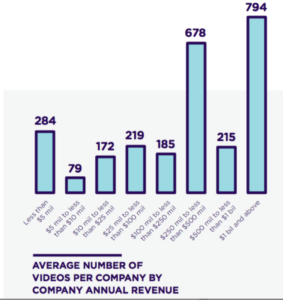If you’re calculating, or recalculating, this year’s video content marketing strategy, Vidyard’s 2017 Video in Business Benchmark Report contains some interesting stats from which we can infer some useful technology business video guidelines . The report’s insights are based on a year’s worth of data covering 500 businesses and over 600 million video streams on Vidyard’s hosting platform.
On average, tech companies publish 21 videos per month.
High tech companies put out more videos than anyone else — 21 per month. Manufacturing companies put out 20; the average is 16. Video libraries are doubling in size every 16 months. Your video output is much lower? Growing your video library is easier than you think. Look at your existing library and see what can be repurposed. Snag a subject matter expert and record some FAQ answers on a smart phone (will probably need some editing, though). Maybe some of your blog posts could be livened up and attract new readers if you add some video snippets to share in social media.
Desktop browsers rule
86% of views of business-related videos take place on desktop browsers. This is important for technology businesses because it means you can add value with interactive features like chapters and branching without worrying overmuch about whether these features will work on mobile devices (probably not). There are plenty of options for turning static longform videos (e.g., webinars) into navigable videos customers will appreciate. Maybe that should be your first repurposing project. It’s not hard to do. There are plenty of online options.
Wednesday is the day with the most viewing
Wednesday between 7AM-11AM PST is the most popular viewing time. This is interesting, and might be worth considering in scheduling email campaigns that link to a video, or planning live streamed video. But viewing actually varies very little across the work week (17% ±1%). Weekends account for 15% of views.
Get to the point fast
The fact that nearly 56% of all published business videos are less than two minutes long is an indication that most companies are aware that people expect business videos to deliver the information they want fast. And consider this: videos under 90 seconds keep only 53% of viewers watching to the end. It’s far less important to end with a flourish than it is to get to the good stuff early.
Use video analytics
77% of companies use some kind of analytics to measure video effectiveness. Obviously, the larger your video budget, the more you care about using analytics. Businesses producing 50 videos or more per year are 2.5x more likely to use advanced video analytics, and those using advanced analytics are far more likely to be increasing their video budgets this year.

Size matters not at all
One that seems to defy explanation is the correlation between company size and the volume of video production. To be sure, the largest companies produce the most videos, but the smallest companies are outproducing the rest. Maybe the only practical technology business guidelines that can be drawn from this, is that no matter who you compete with, there’s a good chance that your competitors are producing more videos than you are 🙂



